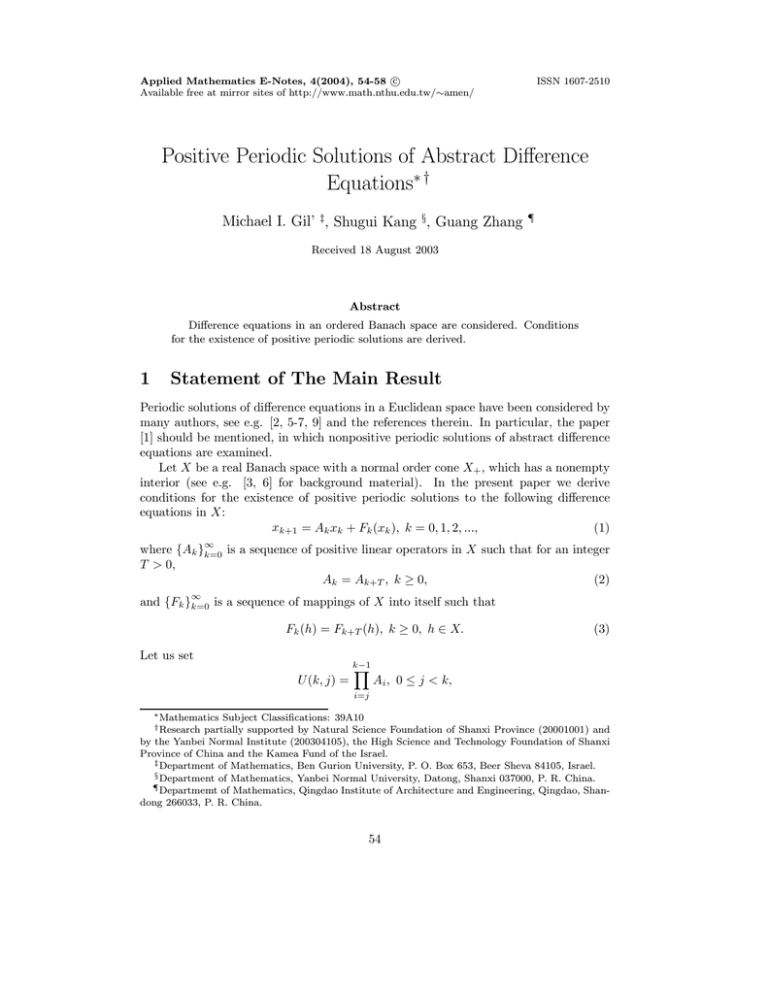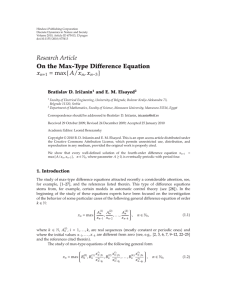Document 10677211
advertisement

Applied Mathematics E-Notes, 4(2004), 54-58 c
Available free at mirror sites of http://www.math.nthu.edu.tw/∼amen/
ISSN 1607-2510
Positive Periodic Solutions of Abstract Difference
Equations∗ †
Michael I. Gil’ ‡, Shugui Kang §, Guang Zhang
¶
Received 18 August 2003
Abstract
Difference equations in an ordered Banach space are considered. Conditions
for the existence of positive periodic solutions are derived.
1
Statement of The Main Result
Periodic solutions of difference equations in a Euclidean space have been considered by
many authors, see e.g. [2, 5-7, 9] and the references therein. In particular, the paper
[1] should be mentioned, in which nonpositive periodic solutions of abstract difference
equations are examined.
Let X be a real Banach space with a normal order cone X+ , which has a nonempty
interior (see e.g. [3, 6] for background material). In the present paper we derive
conditions for the existence of positive periodic solutions to the following difference
equations in X:
xk+1 = Ak xk + Fk (xk ), k = 0, 1, 2, ...,
(1)
where {Ak }∞
k=0 is a sequence of positive linear operators in X such that for an integer
T > 0,
Ak = Ak+T , k ≥ 0,
(2)
∞
and {Fk }k=0 is a sequence of mappings of X into itself such that
Fk (h) = Fk+T (h), k ≥ 0, h ∈ X.
Let us set
U (k, j) =
k−1
\
i=j
(3)
Ai , 0 ≤ j < k,
∗ Mathematics
Subject Classifications: 39A10
partially supported by Natural Science Foundation of Shanxi Province (20001001) and
by the Yanbei Normal Institute (200304105), the High Science and Technology Foundation of Shanxi
Province of China and the Kamea Fund of the Israel.
‡ Department of Mathematics, Ben Gurion University, P. O. Box 653, Beer Sheva 84105, Israel.
§ Department of Mathematics, Yanbei Normal University, Datong, Shanxi 037000, P. R. China.
¶ Departmemt of Mathematics, Qingdao Institute of Architecture and Engineering, Qingdao, Shandong 266033, P. R. China.
† Research
54
Gil’ et al.
55
and
U (j, j) = IX .
Here and below I = IX is the identity operator in X . It is assumed that the spectral
radius rs (U (T, 0)) of the operator U (T, 0) satisfies the inequality
rs (U (T, 0)) < 1.
(4)
THEOREM 1. In additions to conditions (2)-(4), let there be a linear operator S
in X which has a positive inverse operator such that the operators Ak S −1 are compact
and that the functions SFk are positive, continuous in X and monotone decreasing.
Moreover, suppose there is a z ∈ X such that
SFk (u) ≤ z, k = 0, 1, ..., T − 1
for all u ∈ X. Then equation (1) has at least one positive periodic solution.
2
Proof of Theorem 1
It is easily checked that the unique solution of the equation
yk+1 = Ak yk + fk , fk ∈ X, k = 0, 1, ...,
is given by
yk = U (k, 0)y0 +
k−1
[
U (k, j + 1)fj , k = 1, 2, ... .
j=0
Thus, the periodic boundary value problem
yk+1
y0
= Ak yk + fk , fk ∈ X, k = 0, 1, ..., T − 1,
= yT
has a solution provided
y0 = yT = U (T, 0)y0 +
T
−1
[
U (T, j + 1)fj ,
j=0
or
y0 = (I − U (T, 0))
−1
T
−1
[
U (T, j + 1)fj ,
j=0
and in such a case, this solution is given by
yk = U (k, 0) (I − U (T, 0))
−1
T
−1
[
j=0
U (T, j + 1)fj +
k−1
[
j=0
U (k, j + 1)fj , 0 ≤ k ≤ T.
(5)
56
Periodic Solutions of Differnece Equations
Hence the periodic problem for (1) can be written as
xk
= U (k, 0) (I − U (T, 0))−1
+
k−1
[
T
−1
[
U (T, j + 1)Fj (xj )
j=0
U (k, j + 1)Fj (xj )
j=0
=
T
−1
[
Mk,j Fj (xj ),
(6)
j=0
where
Mk,j = U (k, 0) (I − U (T, 0))
−1
U (T, j + 1) + W (k, j), 0 ≤ k ≤ T,
(7)
and W (k, j) = U (k, j + 1) for j < k and W (k, j) = 0 for j ≥ k. Let c(T, X) be the
space of sequences h = {hk ∈ X}Tk=1 with the norm
h
c
= max
k=1,...,T
hk
X.
Rewrite (6) as
x = BΦ(x),
where B is defined by
(Bh)k =
T
−1
[
j=0
Mk,j S −1 hj , h = {hk }Tk=1 ∈ c(T, X)
and Φ(h) = {SFk (hk )}Tk=1 . Since Ak S −1 are compact in X and B is a finite sum of
Ak S −1 , B is compact in c(T, X). Moreover, due to (4),
(I − U (T, 0))
−1
=
∞
[
k=0
U k (T, 0) ≥ 0.
So B ≥ 0.
We now invoke the following result (see Theorem 7.G(c) in [6, pp.309-310]: Let Y
and Z be real ordered Banach spaces. Let the order cone Y+ on Y be normal with
nonempty interior. In addition, let an operator F0 : Y → Z be continuous and an
operator K : Z → Y be linear, compact and positive. Then the equation
u = KF0 (u)
(8)
has a solution u ∈ Y , provided F is monotone decreasing and there is a z0 ∈ Z, such
that
F0 (u) ≤ z0
for all u ∈ Y .
If we now take K = B and F0 = Φ in (8), we arrive at the proof of our result.
Gil’ et al.
3
57
Example
Let c0 be the Banach space of bounded sequences of real numbers with the supremum
norm. Take X = c0 and consider the system
xm+1,j =
∞
[
am,j,k xm,k + fmj (xmj ), j, k = 1, 2, ...; m = 0, 1, ...,
(9)
k=1
where am,j,k is a positive number sequence of three arguments with the properties
am,j,k = am+T,j,k
and
sup
m=0,...,T −1,j=1,2,...
∞
[
am,j,k < 1.
(10)
(11)
k=1
The functions fmj (v) are positive scalar-valued functions which are decreasing as the
argument v ∈ R increases. In addition
fmj (v) = fm+T,j (v), v ∈ R; m = 0, 1, 2, ...; j = 1, 2, ...,
(12)
sup{jfmj (v) : m = 0, ..., T − 1; v ∈ R; j = 1, 2, ...} = z < ∞.
(13)
and
For instance, we can take
fmj (v) =
lm
,
j(1 + v 2 )
where lm is a positive constant for each m = 0, ..., T − 1.Then
z=
max
m=0,...,T −1
lm .
Define operator S by
(Sh)j = jhj , j = 1, 2, ...; h = (hk )∞
k=1 ∈ c0 .
Let us apply Theorem 1 to system (9) with Am defined by
(Am h)j =
∞
[
am,j,k hk
k=1
and
(Fm h)j = fmj (hj ), j = 1, 2, ...; h = (hk )∞
k=1 ∈ c0 .
In view of (11), condition (4) holds (see [4], inequality (16.2)). Operators Am S −1 are
compact in c0 . Moreover, in view of (13), condition (5) holds. Now Theorem 1 implies
that system (9) under conditions (10)-(13) has at least one positive periodic solution
in the space c0 .
58
Periodic Solutions of Differnece Equations
References
[1] M. Gil’, Periodic solutions of abstract difference equations, Applied Math. E-Notes,
1(2001), 18—23.
[2] M. Gil’ and S. S. Cheng, Periodic solutions of a perturbed difference equation, Appl.
Anal., 76(2000), 241—248.
[3] D. J. Guo and V.Lakshmikantham, Nonlinear Problems in Abstract Cones, Academic Press, 1988.
[4] M. A. Krasnosel’skii, J. Lifshits and A. Sobolev, Positive Linear Systems. The
Method of Positive Operators, Heldermann Verlag, Berlin, 1989.
[5] R. Musielak and J. Popenda, On periodic solutions of a first order difference equation, An. Stiint. Univ. “Al. I. Coza” Iasi Sect. I a Mat., 34(2)(1998), 125-133.
[6] E. Zeidler, Nonlinear Functional Analysis and its Applications, Springer-Verlag,
New York, 1986.
[7] R. Y. Zhang, Z. C. Wang, Y. Chen and J. Wu, Periodic solutions of a single
species discrete population model with periodic harvest/stock, Comput. Math.
Appl., 39(2000), 77—90.
[8] G. Zhang and S. S. Cheng, Periodic Solutions of a Discrete Population Model,
Functional Differential Equations, 7(3-4)(2000), 223—230.
[9] Y. Gao, G. Zhang and W. G. Ge, Existence of periodic positive solutions for delay
difference equations, J. Sys. Sci. & Math. Sci., 23(2)(2003), 155—162 (in Chinese).



